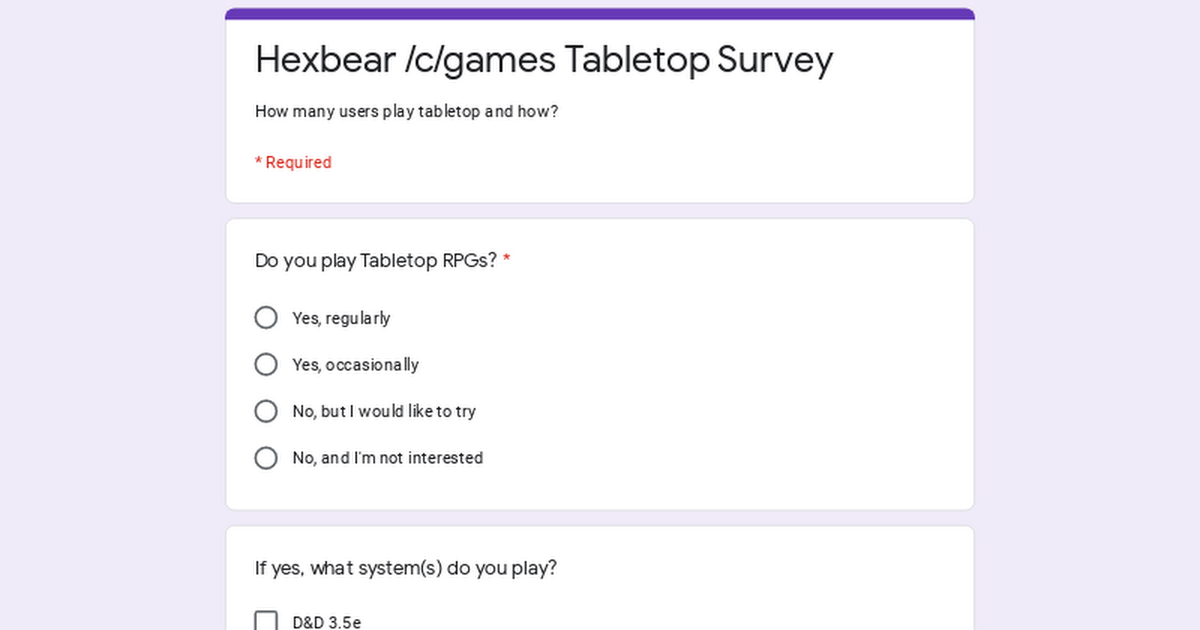I thought this would be useful to know, how many people here play tabletop RPGs and which systems, how, etc..
@Nakoichi , if you think this is a good idea, this could be pinned :stalin-heart: .
Edit: I forgot to say, I'll wait for like a week and make another post with the results!
Edit 2: Survey is done! Results are here -> https://hexbear.net/post/109795



Okay so you'll have to bear with me while I recall Pathfinder 2 critiques, I haven't played the game since 2019 during the playtest/initial release period (my main animosity in the above comment should be directed at 5e) and things may have definitely improved since then. If I recall correctly I didn't care for the mix and match approach to ability/feat progression. In theory this would allow for more dynamism but so many ability were hard level gated by requisite feat trees that the options became irrelevant. My players always specialized one tree for stuff they wanted or were disappointed as the game went on by the number of useless abilities their character had. Another was the action economy simplification. I get the "flexibility" that was to be inherent to just having three actions but most choices you could make with those choices in an encounter were rarely more useful than just hitting the enemy again. Another minor/personal point was that nothing from 1 carried over to 2. I played 3.5 and Pathfinder 1, both of which translate very well between each other mechanically. With a few tweaks most of that content can easily be adapted to 5e (not that I would). 2 is an entirely new beast and so forces everyone to start over when using it.
Fair points. I disagree with a lot of it but I think it's because it heavily depends on playing style for players and GM.
I hated the feat trees/progression in 1e and it was essentially structured in such a way that the majority of it was uninteresting feat taxes and such high requirements that you would never pick the cool stuff (as well as being completely opaque for most players who are not willing to look at every single thing available on a giant excel spreadsheet). PF2e solves this problem for me, because you don't really have feat taxes that only serve to unlock feats, they all give you something fun, and they're very clearly set up in trees along ancestry/class/archetype lines which makes it easy for players to pick and choose.
The combat change is probably the biggest improvement, I now completely hate 3.5e/5e's system of nonsensical actions, it was always a mess, even experienced players had a hard time with it and it annoyed everyone, it's very hard to fit an improvising/free-form style into it as well without messing with it and homebrewing things that are supposed to be impossible by RAW. You could basically do one "thing" per turn and that was it, and if that failed then you're fucked and you wait another 2 minutes for your next turn. The 3 action thing is super clear to explain and use, and there's a ton of default actions, skill actions and class actions to use. I did have a problem similar to what you mentionned at the beginning because the players were mostly used to 5e/PF1e still and they had not wrapped their heads around the new system yet. This is a difficult transition and it also requires good adventure/encounter design to work, something which was pretty bad when PF2e started because Paizo was clearly still new at their own system and the first campaign/couple adventures are pretty wack in terms of difficulty and encounter design. My players rarely attack more than twice, and even then they don't attack more than once that often either. It's not really a viable choice in a good encounter because how less likely you are to hit, except if you're designed for it (agile/two weapon type characters). This is something that took a while for me to get, and I had to work to make the players know and remember the other actions available, as well as design encounters that used them (cover, terrain, importance of recall knowledge/perception of the fight, advantage in using skill actions, enemy stats that require/benefit from player Aiding each other, etc..). The eegrees of success also means every action and spell is way more interesting and useful. I'm a big fan of enemy design in PF2e, they always have one little special trick or feature for the players to figure out. I basically had the opposite problem where in PF1e everyone was just doing "I move, I attack" every turn. Now since I have players who like improvising cool things during fights it's way easier for a player to go "I grab the rope to swing from it, grab the other character as I swing by to bring them with me" and I convert that to Interact -> Move -> Interact. Or "I jump on him from the floor above to attack him and push him down" which converts to Leap/Move -> Attack -> Trip/Shove. I get your point tho, but I think this is basically entirely dependant on encounter/enemy design and how the players fight.
For your last point, yea I agree. It's a damn shame there's no easy way to convert, because I had to leave behind a lot of stuff. I think it's unavoidable and I appreciate that they took the risk in making that jump, but I think it was needed. They reworked a lot of core things from the 3.5/PF1e system, stuff that I personally think was LONG overdue, but that also means breaking changes.
Hey at the end of the day the goal is to have fun and to find the system/styles that we enjoy, so this isn't a competition between systems. My preferences and frustrations as a GM are secondary to that.